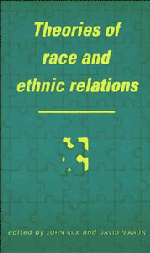Book contents
- Frontmatter
- Contents
- List of contributors
- Preface
- Introduction. Controversies and continuities in race and ethnic relations theory
- 1 Intersecting strands in the theorisation of race and ethnic relations
- 2 Epistemological assumptions in the study of racial differentiation
- 3 The role of class analysis in the study of race relations – a Weberian perspective
- 4 Varieties of Marxist conceptions of ‘race’, class and the state: a critical analysis
- 5 Class concepts, class struggle and racism
- 6 A political analysis of local struggles for racial equality
- 7 Ethnicity and Third World development: political and academic contexts
- 8 Social anthropological models of inter-ethnic relations
- 9 Pluralism, race and ethnicity in selected African countries
- 10 Ethnicity and the boundary process in context
- 11 Ethnicity and the sociobiology debate
- 12 Rational choice theory and the study of race and ethnic relations
- 13 The ‘Chicago School’ of American sociology, symbolic interactionism, and race relations theory
- 14 The operationalisation of identity theory in racial and ethnic relations
- Bibliography
- Index
13 - The ‘Chicago School’ of American sociology, symbolic interactionism, and race relations theory
Published online by Cambridge University Press: 01 June 2011
- Frontmatter
- Contents
- List of contributors
- Preface
- Introduction. Controversies and continuities in race and ethnic relations theory
- 1 Intersecting strands in the theorisation of race and ethnic relations
- 2 Epistemological assumptions in the study of racial differentiation
- 3 The role of class analysis in the study of race relations – a Weberian perspective
- 4 Varieties of Marxist conceptions of ‘race’, class and the state: a critical analysis
- 5 Class concepts, class struggle and racism
- 6 A political analysis of local struggles for racial equality
- 7 Ethnicity and Third World development: political and academic contexts
- 8 Social anthropological models of inter-ethnic relations
- 9 Pluralism, race and ethnicity in selected African countries
- 10 Ethnicity and the boundary process in context
- 11 Ethnicity and the sociobiology debate
- 12 Rational choice theory and the study of race and ethnic relations
- 13 The ‘Chicago School’ of American sociology, symbolic interactionism, and race relations theory
- 14 The operationalisation of identity theory in racial and ethnic relations
- Bibliography
- Index
Summary
Introduction
The contributions of the ‘Chicago School’ to the study of race and ethnic relations have been, undeservedly, neglected by sociologists. In this paper, I set out what I take to be the most important and fruitful ideas that this group of scholars contributed to the study of race relations. I argue that the dominant perspective and method used by the Chicago sociologists to investigate race relations was that of symbolic interactionism. In particular, I refer to the work of Robert E. Park, the major force within the Chicago School, to suggest the effectiveness of the symbolic interactionist approach and how it influenced the thinking of later generations of scholars, and most notably the work of Herbert Blumer. My purpose, then, is to present an overview of the contributions of the Chicago School to the study of race relations and to suggest the usefulness of the approach generated by Park and those sociologists influenced by him. I also point out some of the striking similarities between this approach and current work in urban anthropology and social geography.
In the first section of the paper I discuss the concerns of the Chicago sociologists and the concepts and methods developed to pursue these concerns. I argue that the focus of the theoretical inquiry complemented a general doubt among American intellectuals, confronted by evidence of the disorder in cities, about the possibilities of maintaining a cohesive, orderly urban society capable of reforming itself through the democratic participation of its citizens.
- Type
- Chapter
- Information
- Theories of Race and Ethnic Relations , pp. 280 - 298Publisher: Cambridge University PressPrint publication year: 1986
- 8
- Cited by

